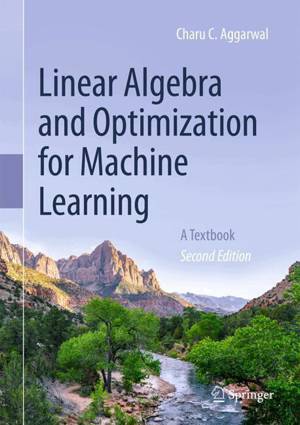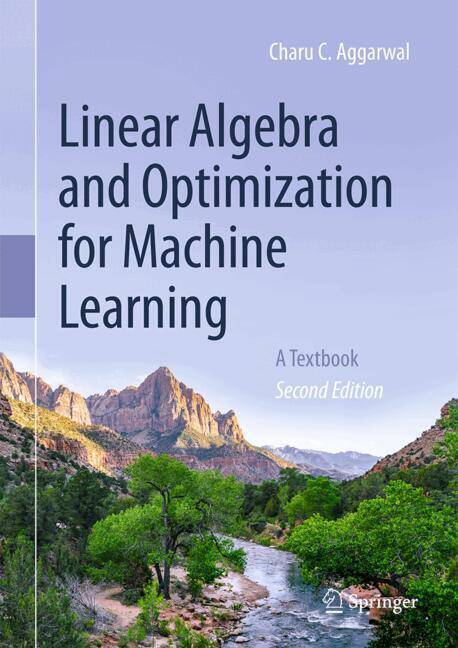
- Retrait gratuit dans votre magasin Club
- 7.000.000 titres dans notre catalogue
- Payer en toute sécurité
- Toujours un magasin près de chez vous
- Retrait gratuit dans votre magasin Club
- 7.000.0000 titres dans notre catalogue
- Payer en toute sécurité
- Toujours un magasin près de chez vous
Linear Algebra and Optimization for Machine Learning
A Textbook
Charu C Aggarwal
Livre relié | Anglais
129,95 €
+ 259 points
Description
This textbook is the second edition of the linear algebra and optimization book that was published in 2020. The exposition in this edition is greatly simplified as compared to the first edition. The second edition is enhanced with a large number of solved examples and exercises. A frequent challenge faced by beginners in machine learning is the extensive background required in linear algebra and optimization. One problem is that the existing linear algebra and optimization courses are not specific to machine learning; therefore, one would typically have to complete more course material than is necessary to pick up machine learning. Furthermore, certain types of ideas and tricks from optimization and linear algebra recur more frequently in machine learning than other application-centric settings. Therefore, there is significant value in developing a view of linear algebra and optimization that is better suited to the specific perspective of machine learning. It is common for machine learning practitioners to pick up missing bits and pieces of linear algebra and optimization via "osmosis" while studying the solutions to machine learning applications. However, this type of unsystematic approach is unsatisfying because the primary focus on machine learning gets in the way of learning linear algebra and optimization in a generalizable way across new situations and applications. Therefore, we have inverted the focus in this book, with linear algebra/optimization as the primary topics of interest, and solutions to machine learning problems as the applications of this machinery. In other words, the book goes out of its way to teach linear algebra and optimization with machine learning examples. By using this approach, the book focuses on those aspects of linear algebra and optimization that are more relevant to machine learning, and also teaches the reader how to apply them in the machine learning context. As a side benefit, the reader will pick up knowledge of several fundamental problems in machine learning. At the end of the process, the reader will become familiar with many of the basic linear-algebra- and optimization-centric algorithms in machine learning. Although the book is not intended to provide exhaustive coverage of machine learning, it serves as a "technical starter" for the key models and optimization methods in machine learning. Even for seasoned practitioners of machine learning, a systematic introduction to fundamental linear algebra and optimization methodologies can be useful in terms of providing a fresh perspective. The chapters of the book are organized as follows. 1-Linear algebra and its applications: The chapters focus on the basics of linear algebra together with their common applications to singular value decomposition, matrix factorization, similarity matrices (kernel methods), and graph analysis. Numerous machine learning applications have been used as examples, such as spectral clustering, kernel-based classification, and outlier detection. The tight integration of linear algebra methods with examples from machine learning differentiates this book from generic volumes on linear algebra. The focus is clearly on the most relevant aspects of linear algebra for machine learning and to teach readers how to apply these concepts. 2-Optimization and its applications: Much of machine learning is posed as an optimization problem in which we try to maximize the accuracy of regression and classification models. The "parent problem" of optimization-centric machine learning is least-squares regression. Interestingly, this problem arises in both linear algebra and optimization and is one of the key connecting problems of the two fields. Least-squares regression is also the starting point for support vector machines, logistic regression, and recommender systems. Furthermore, the methods for dimensionality reduction and matrix factorization also require the development of optimization methods. A general view of optimization in computational graphs is discussed together with its applications to backpropagation in neural networks. The primary audience for this textbook is graduate level students and professors. The secondary audience is industry. Advanced undergraduates might also be interested, and it is possible to use this book for the mathematics requirements of an undergraduate data science course.
Spécifications
Parties prenantes
- Auteur(s) :
- Editeur:
Contenu
- Nombre de pages :
- 650
- Langue:
- Anglais
Caractéristiques
- EAN:
- 9783031986185
- Date de parution :
- 19-09-25
- Format:
- Livre relié
- Format numérique:
- Genaaid
- Dimensions :
- 178 mm x 254 mm

Les avis
Nous publions uniquement les avis qui respectent les conditions requises. Consultez nos conditions pour les avis.






